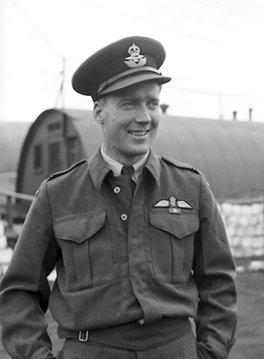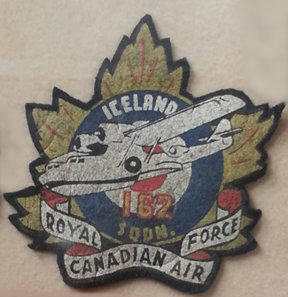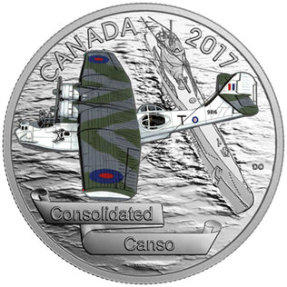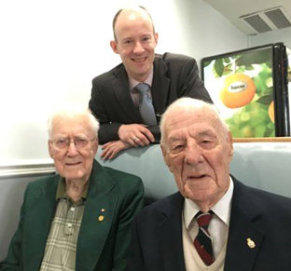Wartime Heritage
ASSOCIATION

copyright © Wartime Heritage Association
Website hosting courtesy of Register.com - a web.com company
Flight Lt. James ‘Jim’ Marshal McRae, DFC, CD
WWII Veteran Royal Canadian Air Force

WWII Veteran Flight Lt. James ‘Jim’ Marshal McRae, DFC, CD, of Yarmouth, Nova
Scotia, was born Wednesday, November 28, 1917, in Huxley, Alberta, the son of
Gordon Stewart McRae and Gertrude Sarah Marshall, and the brother of Hector Earl
McRae.
He followed his younger brother Flying Officer Hector Earl McRae to Brandon,
Manitoba in 1942 where they both gained their wings as pilots with the RCAF. McRae
(Service No. J/20176) was stationed with 162 Squadron, based in Yarmouth and later
Reykjavík.
Their mission was to patrol and protect the Atlantic from German U-boats. It was on
one of these patrols, the Vickers PBV-1A Canso A (PBY-5A) aircraft he was co-piloting
with Wing Commander GW Chapman was shot down in the waters off Iceland by the
submarine they had just damaged. Three of his colleagues succumbed to hypothermia,
and he was later awarded the DFC for his bravery. Sadly, his brother’s plane was shot
down during the war, never to be located.
On June 13, 1944, they and six other crew members took off from Wick, Northern
Scotland, in Canso 9816 "T" to patrol for submarines off Norway. McRae was the first to spot the small wake from the periscope
and snorkel of a German U-boat.
“Our process was to dive over the submarine at 60-feet altitude and drop a stick
of depth charges, four of them. We did that successfully and managed to sink the
submarine,” Jim says. Waterbury remembers feeling confident that the sub was
destroyed. “He was a dead duck as far as we were concerned,” he says. “He
wasn’t.”
The pilot took the plane high and circled to lessen the danger of possible
retaliation. The sub’s bow and conning tower disappeared, and the tail came up
out of the water.
The plane circled again and flew over so pictures could be taken.
“The first thing I knew, the captain could see that the sub was firing. I breathed a
sigh of relief because as we passed over, I thought, well, we’re ok. Then, pow,
we were hit,” says McRae.
The intercom failed with the microphone stuck on. All the men could hear was a roar.
Climbing to 1,000 feet, the crew hoped to make it home in the damaged aircraft. It wasn’t in the cards.
“The pilot couldn’t feather the propeller because of the damage to the engine and she couldn’t maintain altitude,” says McRae.
The plane descended lower and lower.
Wireless operator Joseph Bergevin sat in the aircraft dangerously close to the
time it went down and kept sending out an SOS message. She hit the water on a
moderate swell, bouncing off the top of the first wave, hitting harder the second
time. The third time seemed to be on the downside of the wave, and it was
gentler. They were down safely, but there was a big hole in the bottom of the
aircraft. They had about 15 minutes or so to put on their ditching suits.
“Remember those, Dave?” “I sure do,” says Waterbury. “But what I remember is
the second time we hit, I thought, here we go, Cheerio,” he adds. The ditching
suits were made of rubberized fabric. At first the men found they floated like
corks … until the suits began to fill with water. Scrambling with limited time, the
crew deployed both dinghies. Signal cartridges, Gibson girl radios, rescue pistol…
almost everything for survival was in the one that Waterbury was the first to
climb into on the port side. But the dinghy was overfilled with CO2 and exploded,
losing everything.
“All of a sudden I was in the water with all of the cameras,” says Waterbury. “Frank Reid, a big, tall guy, grabbed a hold of me. I
was all covered with oil and grease. He hauled me back into the airplane.”
The men piled into the remaining dinghy, which had also punctured a corner. Each took turns holding a hand over the leak.
“Eight men in a five-person leaking dinghy… it was a hell of a situation,” says Waterbury.
Hours later a larger lifeboat was air-dropped by a Norwegian crew aboard an RAF aircraft. However, it landed several hundred
yards away and ended up semi-submerged. Waterbury swam over and retrieved it.
Three of the crew died due to exposure before the rest were rescued by an air-force high-speed launch. The three who died
were Flight Sergeant Harry Clifford Leatherdale (Service No. R/52458, Engineer), WO2 Frank Keith Reed (Service No. R/98472,
Wireless Air Gunner), and Flight Sergeant Gerald Frank Staples (R/174860, Wireless Air Gunner).
As a result of the incident, Commanding officer G. W. Chapman (Pilot) was awarded the Distinguished Service Order, WO2 J. J.
C. Bergevin (Service No. R117327, Wireless Air Gunner), Flight Officer McRae (Pilot) and Pilot Officer David John Cunningham
Waterbury (Navigator) received the Distinguished Flying Cross, and Sergeant B. F. Cromarty (Service No. 22030, Engineer), the
Distinguished Flying Medal.
When the war ended in 1945, McRae returned to civilian life in Yarmouth with his wife Margaret Nickerson who he had met
while stationed in Yarmouth. For a time, he drove for MacKenzie Bus Lines from Yarmouth to Halifax, was a Senior Firefighter
for the Yarmouth Fire Department, and finally with his military colleague, Gerald McKay, established the Yarmouth Flying
School.
The call of the RCAF beckoned, and once more he enlisted, with postings at Torbay NL, Greenwood NS, Marville France, and
Bagotville, Quebec. While in Bagotville, he donned the blue beret of the UN Peacekeepers while helping set up a control tower
in the Congo. McRae retired in 1963 and once again returned to civilian life in Yarmouth. He sold McCain potato chips until
securing a position with Canada Customs. He retired as Superintendent from this job at age 65.
Jim McRae was in the audience when Wartime Heritage (440 Productions) presented a number of theatrical stage shows at
Th’YARC in Yarmouth, NS, including the Time to Remember productions of Songs and Stories of the War Years, A Tribute to the
Men and Women of WWII, and Tragedy and Triumph – Memories of WWII.
Jim presented the history of 162 Squadron and his memories of his wartime experiences in 2009 at the Yarmouth air show, and
later, in 2010, Gay Gaudet of Wartime Heritage presented the same with Jim in Yarmouth, Nova Scotia at the Yarmouth
Museum, and included information from the book Canadian Squadrons of Coastal Command. Gary presented the information and
together they answered questions from those in attendance.
In 2016, Jim, age 98, and Pilot Officer David Waterbury, age 95 and who served
as Navigator on Canso 9816, spent time together in Yarmouth on the 72nd
Anniversary of their survival. Gary Gaudet from Wartime Heritage joined them for
their reunion. David Waterbury was born in Halifax on March 2, 1921, and died
March 12, 2021, age 100, at the Veteran's Unit of Fishermen's Memorial Hospital,
in Lunenburg, NS.
James McRae died on Tuesday, April 9, 2024, at the age of 106. He was the last
surviving WWII veteran to receive the Distinguished Flying Cross. Our members
last had the opportunity to see Jim at the rededication of the Yarmouth Cenotaph
in June 2023.
A service was held April 15, 2024, in Yarmouth, NS, and a second service will be
held at Veterans’ Place in Yarmouth on May 15. James Marshal McRae will be
interred at the Arthurvale Cemetery (Saint Hilda’s) in Elnora near James’ birth
town of Huxley, Alberta.
A Royal Canadian Legion Service will be held (June 21, 2024), at the Yarmouth
airport when the heritage Canso aircraft 11094 that Jim flew will be there.




Jim McRae, age 98, with Gary Gaudet of the
Wartime Heritage Association, and Dave
Waterbury, age 95 in 2016


- World War I - Menu
- WWI Stories and Articles
- Photos - Yarmouth Soldiers
- Selection of World War I Songs
- WWI Casualties of Yarmouth, NS
- Those Who Served - Yarmouth, NS
- WWI Casualties Digby Co. NS
- WWI Casualties Shelburne Co. NS
- Merchant Mariners (1915) Yarmouth, NS
- Canadian Forestry Corps - Non Yarmouth Birth/Residence Enlistments
- US Draft Registry - Yarmouth NS Born


- World War II - Menu
- WWII Stories and Articles
- Telegraphist Air Gunners
- WWII Casualties of Nova Scotia
- US Casualties with NS Connection
- Far East/Pacific Casualties with NS Connection
- Merchant Navy Casualties Nova Scotia
- Nova Scotia WWII Casualties Holten Canadian War Cemetery
- D-Day Casualties - Nova Scotia
- CANLOAN Program Casualties - Nova Scotia
- Battle of the Bulge Casualties - Nova Scotia
- WWII Casualties Yarmouth NS
- Yarmouth Casualties - RCAF RAF Canadian Army WWII
- Yarmouth Co., Marrages WWII
- Casualties Non-Born/Residents with Connection to Yarmouth Co., Nova Scotia.
- WWII Casualties Digby Co., NS
- Non-Nova Scotian WWII Casualties Buried in Nova Scotia
- WWII RCAF Casualties Aged 16-18
- Brothers/Sisters Who Served - World War II













